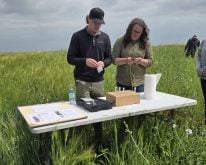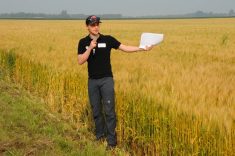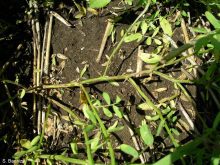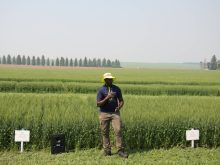Producers began using Group 14 herbicides once weeds started to appear in fields that were resistant to glyphosate
A kochia population collected from central Saskatchewan in 2021 is resistant to Group 14 foliar and soil residual active ingredients.
Charles Geddes, a research scientist in weed ecology at Agriculture Canada’s research centre in Lethbridge, said growers dealing with kochia should keep a lookout for this type of resistance.
“I think it is a significant concern. The biggest concern that I can see is for the pre-plant burn-down window,” Geddes said.
He said farmers in conservation and no-till systems traditionally used glyphosate for their pre-plant burn-downs.
Read Also

Canadian farmers need level playing field for regulations – says Minister MacDonald
Federal agriculture minister Heath MacDonald is urging the Canadian Food Inspection Agency and the Pest Management Regulatory Agency to speed up their decision making.
Once glyphosate-resistant kochia started showing up, many growers mixed in a Group 14 product with glyphosate for burn-downs.
However, in areas where the kochia developed glyphosate resistance, this meant there was only a single effective mode of action on kochia, which that caused selection pressure for Group 14 resistance.
“Now we’re seeing at least the first cases of Group 14 resistance in Western Canada. With kochia, herbicide-resistance traits can spread quite rapidly. So, it’ll be important for scouting efforts to keep an eye on the potential for this showing up in fields moving forward,” Geddes said.
“To date, we’ve done testing on saflufenacil, carfentrazone and sulfentrazone. We still need to characterize the response to some of these other Group 14 products, so we don’t know if it’s resistant to all Group 14 at this time.”
In December, Geddes said he suspected this kochia population was resistant to Group 14 PPO inhibitors. He had to follow that up with an intricate confirmation process.
The first step was to conduct a dose response on plants grown from seeds collected from this kochia population.
Researchers started with saflufenacil foliar applied because it was easier and less dependent on soil type compared to soil-applied products.
In the initial experiment, some plants survived the highest rates in the test, 33 times the standard field rate of saflufenacil.
Researchers then had to show the resistant trait was passed on to the next generation, so they grew collected seeds in a greenhouse, gathered seeds from this second generation and repeated the dose response experiment.
“Through that we confirmed that the population was 63 to 82 fold resistant to saflufenacil-applied foliar, which is well beyond the threshold to confirm resistance,” Geddes said.
Researchers then worked with different PPO inhibitors because there can be resistance variability, especially when dealing with a mode of action that has both foliar- and soil-residual activity.
“There is definitely a differential response between the resistance population and the two susceptibles that we tested for sulfentrazone applied directly to the soil,” he said.
Researchers are still working on the level of resistance this kochia population has to sulfentrazone.
Geddes said researchers have found this kochia population is resistant to a soil-applied Group 14 product, but it’s more resistant to foliar-applied Group 14 chemistries.
“We’re still seeing a lack of control at common field rates for sulfentrazone, but it might not be quite as obvious as the foliar-applied products.”
After finding the kochia population in 2021, researchers tested samples from 900 kochia populations collected across the Prairies between 2018 and 2021. The samples were grown and tested in a dose response survey and no Group 14 resistance was found.
“So that’s an indication that it’s not very widespread, at least for that time period, but it’ll be important to keep an eye out with kochia populations moving forward,” Geddes said.
In 2022, researchers from North Dakota State University also discovered kochia they suspected have resistance to Group 14 products.
Geddes said there is a greater likelihood growers will return to tillage for pre-plant kochia weed control as they lose important products to herbicide resistance.
“It may start with just using tillage for patch management. Based on the biology of kochia, tillage can be a viable tool. But of course it’s important to use tillage judiciously and only when necessary, thinking about the system from a perspective that goes beyond weed management and looks at the sustainability of the cropping system overall,” Geddes said.
















